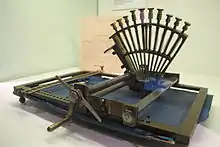Pierre-François-Victor Foucault
Pierre-François-Victor Foucault (1797–1871) was the inventor in 1843 of the first printing machine for braille, the decapoint.

Life
A pupil of the Institut National des Jeunes Aveugles, Foucault married Thérèse-Adèle Husson, a blind author, in 1826.[1] This marriage gave birth to two daughters. After his wife's death in 1831, following a fire, he married a seamstress (non blind) in 1832, Adélaïde Louise Juteau.[2] This allowed him to become a resident of the Quinze-Vingts (marriages between blind people were prohibited), which gave him the financial possibility to collaborate with Louis Braille.
The raphigraphe
His invention was awarded a platinum medal by the Société d'encouragement pour l'industrie nationale, then he showed it at The Great Exhibition (1851) in London.[3]
References
- Weygand, Zina (2015-07-08). Religion et enfermements : XVIIe-XXe siècles. Histoire. Presses universitaires de Rennes. pp. 203–215. ISBN 9782753532298. Retrieved 27 September 2018.
- "État civil reconstitué de la ville de Paris". archives.paris.fr. p. 43. Retrieved 27 September 2018.
- Mellor, C. Michael (2006). Louis Braille: A Touch of Genius. National Braille Press. p. 90. ISBN 9780939173709. Retrieved 27 September 2018.
Pierre-François-Victor foucault.